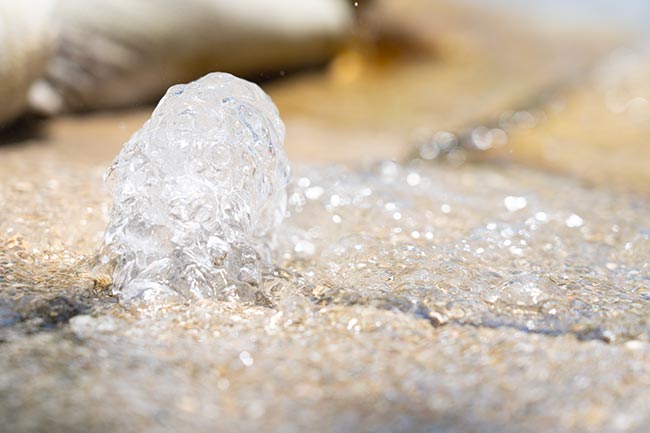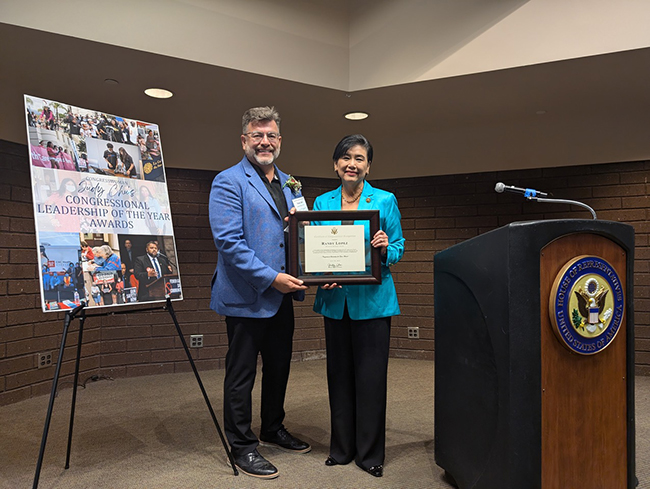Golden State: surface water from Claremont aquifer no cause for concern

For the past several weeks residents near Pilgrim Place have watched water surge from the ground near the corner of Seventh Street and Berkeley Avenue. Golden State Water says it is the naturally occurring result of a swollen aquifer. Courier photo/Andrew Alonzo
By Andrew Alonzo | aalonzo@claremont-courier.com
For the last several weeks, residents near Pilgrim Place have watched with alarm as water surged from the ground near the corner of Seventh Street and Berkeley Avenue and fell into a storm drain near Harrison Avenue.
Neighbors have shared concerns about the seemingly free flowing water amid rising water bills and well-publicized calls for conservation from Golden State Water Company, Claremont’s water supplier.
And though the alarm seems well founded — after all, Southern Californians and Claremonters have grown accustomed to living in drought conditions, despite generous precipitation over the previous two winters — officials say the flow is naturally occurring and will not impact ratepayers’ bills.

For the past several weeks residents near Pilgrim Place have watched water surge from the ground near the corner of Seventh Street and Berkeley Avenue. Golden State Water says it is the naturally occurring result of a swollen aquifer. Courier photo/Andrew Alonzo
“In time, this naturally occurring condition will subside. In the meantime, Golden State Water is monitoring the situation and will keep customers informed as conditions evolve,” Golden State Water’s Ken Vecchiarelli wrote in an email.
The company is not “purposely discharging water, running water to waste, or failing to properly operate and maintain the water system infrastructure,” wrote Vecchiarelli. “The flowing water you inquired about is caused by a naturally occurring artesian well condition.
“These circumstances occur when the underground aquifer has positive pressure sufficient to push water up to the surface. The condition is common in this area after heavy rains and rising groundwater levels and can sometimes continue for weeks or months. As you know, Southern California has experienced high rainfall for the past two years. Claremont has several cienegas (wetlands or marshes) that can become active after heavy rains, sometimes resulting in artesian conditions.
“These cienegas are well-documented and were referenced recently in a presentation to Six Basins Watermaster at their Board Meeting on March 27, 2024 … There are several historical documents and some interesting pictures referencing this part of Claremont’s history, included within this presentation. Similar artesian conditions occurred in this area in 2004 and 1968.”
The presentation is viewable at 6bwm.com by clicking “meetings,” then “presentation,” “March 27 board meeting info.”
The flowing water will not affect GSW customers’ water bills. “It has not made its way into the distribution system at this point,” Vecchiarelli wrote. “This artesian water is analogous to water that might be seeping out of a hillside naturally or coming up from a natural spring.”
There are three wells within Claremont’s Martin cienegas area: Berkeley, Harrison 2, and Dreher 1. Further northwest lies the Ford 1 well. According to the presentation, only the Berkeley well — where neighbors have been inquiring about the flow near Seventh and Berkeley — has “exhibited high groundwater since 1972.”
“The reasons for these discrepancies in water levels at these wells are not fully understood,” according to the GSW presentation. “Groundwater-levels in this area react to the local hydrology (wet vs. dry conditions), however, the Berkeley well is the only one with high groundwater conditions. The Berkeley well is located near Pilgrim Place, where high groundwater has occurred as recently as 2006, and now in 2024.”
Asked if the Sierra Nevada snowpack has anything to do with the local groundwater seepage, Vecchiarelli explained it’s possible, but unlikely.
“The snowpack in the Sierra Nevada Mountains can impact source water supply to Claremont (and much of Southern California) through the State Water Project (SWP) deliveries. However, these impacts are more indirect than the local watershed from the nearby San Gabriel Mountains,” he wrote. “As a member of the Three Valleys Municipal Water District (TVMWD), Golden State Water Company has access to supplemental import water to its Claremont customers from the SWP. This import water source is fed primarily through runoff from the Sierra Nevada Mountains. It is delivered to much of Southern California through the Metropolitan Water District of Southern California (MWD), the same agency that built, maintains and operates the Colorado River Aqueduct (CRA), which also provides supplemental import water to much of Southern California.”
Last month, the Chino Basin Water Conservation District announced its percolation basins began receiving approximately 19,000-acre feet of water, equivalent to 6.2 billion gallons, from the California State Water Project via Metropolitan Water District of Southern California and the Inland Empire Utilities Agency. The influx of water will fill CBWCD’s percolation basins to replenish Chino Basin’s aquifer.
“Recently, the Department of Water Resources announced an increase in allocation from the State Water Project from 30 to 40 percent due to this year’s healthy Sierra Nevada Snowpack,” read a Chino Basin Water Conservation District news release. “It will take up to eight months to complete this water delivery, and CBWCD’s basins are scheduled to be banking imported water from the Sierras through December 2024.”
Communities served by the Chino Basin include Chino, Chino Hills, Fontana, Montclair, Ontario, Rancho Cucamonga, and Upland.









0 Comments